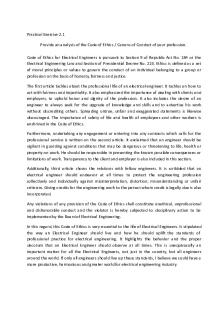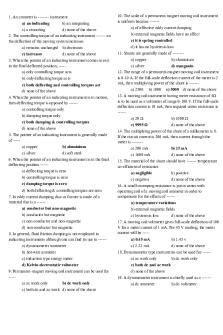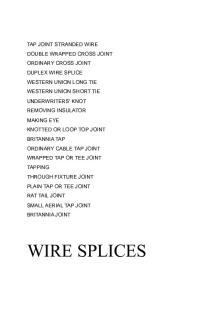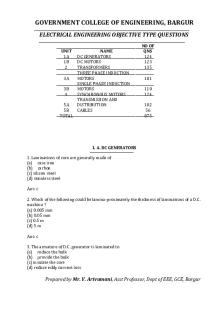Practical Exercises - Electrical Engineering Laws PDF

| Title | Practical Exercises - Electrical Engineering Laws |
|---|---|
| Author | Jeanfel Tumbaga |
| Course | Electrical Engineering |
| Institution | Batangas State University |
| Pages | 4 |
| File Size | 51.4 KB |
| File Type | |
| Total Downloads | 65 |
| Total Views | 151 |
Summary
Electrical Engineering Laws...
Description
Practical Exercise 2.1 Provide an analysis of the Code of Ethics / Canons of Conduct of your profession. Code of Ethics for Electrical Engineers is pursuant to Section 9 of Republic Act No. 184 or the Electrical Engineering Law and Section of Presidential Decree No. 223. Ethics is defined as a set of moral principles or values to govern the conduct of an individual belonging to a group or profession on the basis of honesty, fairness and justice. The first article tackles about the professional life of an electrical engineer. It tackles on how to act with fairness and impartiality. It also emphasized the importance of dealing with clients and employers, to uphold honor and dignity of the profession. It also includes the desire of an engineer to always seek for the upgrade of knowledge and skills and to advertise his work without discrediting others. Spreading untrue, unfair and exaggerated statements is likewise discouraged. The importance of safety of life and health of employees and other workers is enshrined in the Code of Ethics. Furthermore, undertaking any engagement or entering into any contracts which calls for the professional service is written on the second article. It exclaimed that an engineer should be vigilant in guarding against conditions that may be dangerous or threatening to life, health or property on work. He should be responsible in presenting the known possible consequences or limitations of work. Transparency to the client and employer is also included in this section. Additionally, third article shows the relations with fellow engineers. It is scribbled that an electrical engineer should endeavor at all times to protect the engineering profession collectively and individually against misinterpretation, distortion, misunderstanding or unfair criticism. Giving credits for the engineering work to the person whom credit is legally due is also incorporated. Any violations of any provision of the Code of Ethics shall constitute unethical, unprofessional and dishonorable conduct and the violator is hereby subjected to disciplinary action to be implemented by the Board of Electrical Engineering. In this regard, this Code of Ethics is very essential to the life of Electrical Engineers. It stipulated the way an Electrical Engineer should live and how he should uplift the standards of professional practice for electrical engineering. It highlights the behavior and the proper decorum that an Electrical Engineer should observe at all times. This is unequivocally an important matter for all the Electrical Engineers, not just in the country, but all engineers around the world. If only all engineers should live up these standards, I believe we could have a more productive, harmonious and greater world for electrical engineering industry.
Practical Exercise 2.2 Provide a summary/analysis by article the Intellectual Property Rights Law. Republic Act No. 8293 is an act prescribing the Intellectual Property Code and establishing the Intellectual Property Office, providing for its powers and function and for other purposes otherwise known as the Intellectual Property Code of the Philippines. Intellectual property rights help protect creations of the mind that include inventions, literary or artistic work, images, symbols, etc. If you create a product, publish a book, or find a new drug, intellectual property rights ensure that you benefit from your work. These rights protect your creation or work from unfair use by others. The intellectual property rights under the Intellectual Property Code are as follows: 1. 2. 3. 4. 5. 6. 7.
Copyright and related rights; Trademarks and service marks; Geographic indications; Industrial designs; Patents; Layout designs [topographies] of integrated circuits; and Protection of undisclosed information.
The State recognizes that an effective intellectual and industrial property system is vital to the development of domestic and creative activity, facilitates transfer of technology, attracts foreign investments, and ensures market access for our products. It shall protect and secure the exclusive rights of scientists, inventors, artists and other gifted citizens to their intellectual property and creations, particularly when beneficial to the people. The use of intellectual property bears a social function. To this end, the State shall promote the diffusion of knowledge and information for the promotion of national development and progress and the common good. It is also the policy of the State to streamline administrative procedures of registering patents, trademarks and copyright, to liberalize the registration on the transfer of technology, and to enhance the enforcement of intellectual property rights in the Philippines. The effects on international conventions and on principle of reciprocity are enshrined in this act. It states that any person who is a national or who is domiciled or has a real and effective industrial establishment in a country which is a party to any convention, treaty or agreement relating to intellectual property rights or the repression of unfair competition, to which the Philippines is also a party, or extends reciprocal rights to nationals of the Philippines by law, shall be entitled to benefits to the extent necessary to give effect to any provision of such
convention, treaty or reciprocal law, in addition to the rights to which any owner of an intellectual property right is otherwise entitled by this Act. The Intellectual Property Code of the Philippines is divided into five parts: PART I - The Intellectual Property Office It shall protect and secure the exclusive rights of scientists, inventors, artists and other gifted citizens to their intellectual property and creations, particularly when beneficial to the people, for such periods as provided in this Act. The use of intellectual property bears a social function. PART II - The Law on Patents A patent is an exclusive right to an invention that introduces a new solution or a technique. If you own a patent, you are the only person who can manufacture, distribute, sell, or commercially use that product. Patents are usually granted for a period of 20 years. The technology that powers self-driving cars is an example of a patented invention. It is responsible in providing the framework and support system for the ownership, management and commercialization of the intellectual property generated from research and development funded by government and for other purposes. PART III - The Law on Trademarks, Service Marks and Trade Names Industrial property rights include trademarks, patents, geographical indications, and industrial designs. A trademark is a unique sign used to identify a product or a service. It can be a single word or a combination of words and numbers. Drawings, 3-D signs, or even symbols can constitute a trademark. For instance, Google is a famous trademark. The trademark application can be filed at national or regional levels depending on the extent of protection required. PART IV - The Law on Copyright Copyrights give authors the right to protect their work. It covers databases, reference works, computer programs, architecture, books, technical drawings, and others. By copyrighting your work, you ensure that others cannot use it without your permission. PART V - Final Provisions This part details the appeals, abolition of the bureau of patents, trademarks and technology transfers. This also preserves the existing rights, appropriations and the possible repeals. This also includes the separability and effectivity clauses.
Here are the significant features of the law: 1. A shift was made from the "first-to-invent system" under R. A. 165 [old law] to "first-tofile system" under the new law. 2. In the case of inventions, the period of the grant was increased from 17 years from grant under the old law to 20 years from date of filing under the new law. 3. In the case of utility models, the previous grant of 5 years plus renewals of 5 years each under the old law was changed to 7 years without renewal under the new law. 4. In the case of industrial designs, the previous grant of 5 years plus renewals of 5 years each was maintained. 5. Under the old law, there was no opposition proceedings and the examination is mandatory; under the new law, the examination is made only upon request [possibly with or without examination]. 6. Under the old law, publication is made after the grant; under the new law, publication is effected after 18 months from filing date or priority date. 7. Under the old law, the penalties for repetition of infringement are: PhP10,000 and/or 5 years of imprisonment and the offense prescribes in 2 years; under the present law, the penalties range from PhP100,000 to PhP300,000 and/or 6 months to 3 years of imprisonment and the offense prescribes in 3 years....
Similar Free PDFs
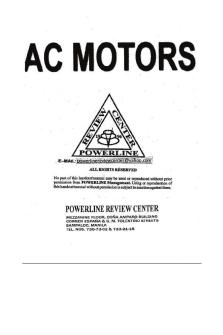
AC Motors101 Electrical Engineering
- 17 Pages

Electrical engineering - Wikipedia
- 18 Pages

Chemical Engineering Laws & Ethics
- 14 Pages

Practical - Lab exercises
- 55 Pages

Practical-Week5+6-Exercises
- 1 Pages

Practical exercises - Page Maker
- 1 Pages

AFAR-Practical Exercises
- 6 Pages
Popular Institutions
- Tinajero National High School - Annex
- Politeknik Caltex Riau
- Yokohama City University
- SGT University
- University of Al-Qadisiyah
- Divine Word College of Vigan
- Techniek College Rotterdam
- Universidade de Santiago
- Universiti Teknologi MARA Cawangan Johor Kampus Pasir Gudang
- Poltekkes Kemenkes Yogyakarta
- Baguio City National High School
- Colegio san marcos
- preparatoria uno
- Centro de Bachillerato Tecnológico Industrial y de Servicios No. 107
- Dalian Maritime University
- Quang Trung Secondary School
- Colegio Tecnológico en Informática
- Corporación Regional de Educación Superior
- Grupo CEDVA
- Dar Al Uloom University
- Centro de Estudios Preuniversitarios de la Universidad Nacional de Ingeniería
- 上智大学
- Aakash International School, Nuna Majara
- San Felipe Neri Catholic School
- Kang Chiao International School - New Taipei City
- Misamis Occidental National High School
- Institución Educativa Escuela Normal Juan Ladrilleros
- Kolehiyo ng Pantukan
- Batanes State College
- Instituto Continental
- Sekolah Menengah Kejuruan Kesehatan Kaltara (Tarakan)
- Colegio de La Inmaculada Concepcion - Cebu
